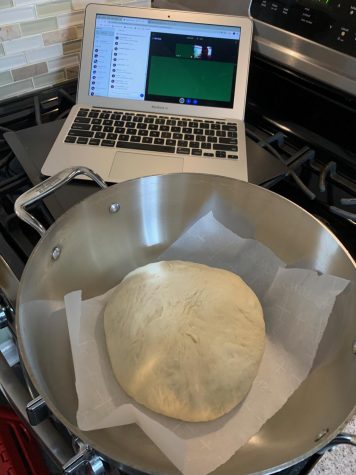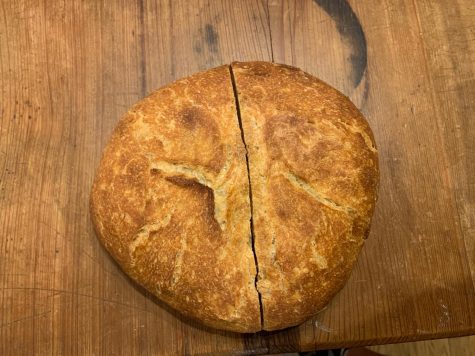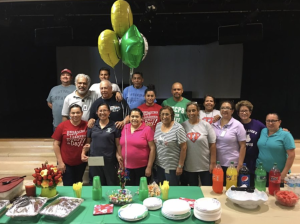Feeling sour? Make sourdough
December 7, 2020

Early in 2020, billions of people suddenly found themselves at home in quarantine. With extra time on their hands, the world collectively gained a new hobby: making bread.
Though the sourdough craze might seem like a relic of early quarantine, long ago, it shouldn’t be—I have been developing my sourdough this past month, and there’s even more to come. Here’s my experience making this bread and the science behind sourdough.
Starting with starter
It all began with the starter. The starter replaces yeast when making sourdough; it’s the agent behind the rise. Starters can be homemade, like in my case, can be purchased online, or can be inherited through generations of family. The longer the starter has been around, the more flavorful and complex it is.
Making the starter was my favorite piece of the story. I mixed water and bread flour together and put it on the shelf to wait. As I waited, the mixture started to bubble and grow; the starter doubled in the first 24 hours of sitting in my tupperware on a shelf. It grew from flour and water into a bubbling substance that smelled a little funky. The aroma was a bizarre combination of cauliflower, vinegar, and a lovely fruit flavor.
Each morning for six days, I would wake up 10 minutes earlier than normal to run downstairs and check on it’s progress, and then I would remove most of the substance and add more flour and water. From these two standard ingredients, a whole new thing started to develop: yeast. I was making wild yeast!
It gave me a routine; something to be excited about and brighten my day. I wanted to tell everyone who would listen about this yeast I was growing (as many of my fellow Lasso writers can corroborate). Now, after a few weeks and multiple attempts at bread, the starter sits in the back of my fridge and I feed it once a week to keep it from withering away. As weird as it seems, the starter is a living organism, and if I forget to sustain it, it will die.
After my starter grew more consistently, I could start the real bread process. I fed my starter one last time and went to bed, ready to bake in the morning; I knew this was going to take all day.
The first attempt
I followed my recipe exactly mixing up starter, water, flour, oil, and salt and I left it to rise. Being a committed baker, and having nothing else to do all day after clearing my schedule, I decided to do a series of folds that some sourdough bakers do. Folding the dough strengthens it and helps develop gluten.
Here is where my issue began: my first fold. The dough is meant to be stretchy and smooth, making it easy to work with. However, I soon discovered that something was wrong; my dough was solid and tough, impossible to pull or move. And yet I persisted.
Despite its toughness, I managed to get a few folds in over the 8 hours my dough was meant to be rising. Every time I went to check on my dough, I was disappointed; it barely rose and just grew more and more solid. By the end of the day, I decided not to bother baking it. It was a rock solid lump that had no air. I reluctantly trashed my dough and went back to the drawing board.
Ready for baking?
I started again, this time on a school day. I decided that baking on a school day would help my impatience from infringing on the bake. I had classes, so I couldn’t interrupt the rising process every few minutes.
After talking to a friend who made sourdough earlier in the year and doing some independent research, I decided that my recipe had much too much flour. I started again, this time with less flour – approximately ½ of a cup.
I mixed up all my ingredients and, again, I left it to rise. After my first class of the day, I checked on it: better than the first try, but still not great. Despite being severely discouraged, I did not give up; it had only been one hour of a multi-hour process.
Once again, I attempted to fold; the dough was more malleable than the first try, but still not perfect. After a few hours I decided to take the leap and attempt to bake it.
I preheated my oven to a high temperature, prepared the dough, and left it for a final rise. I put my dough in the dutch oven – a ceramic cooking pot – and placed it in the oven. Two fatal mistakes were made: I forgot to turn down the oven’s temperature, and I forgot to put the lid on the pot.
Lidless and far too hot, my bread was left to bake for the first 20 minutes. Soon after, I realized both mistakes, made the quick adjustments, and popped it back into the oven for its final bake. But, alas, I forgot to set a timer.
I retreated to the porch feeling accomplished; I had bread in the oven, I’d fixed my mistakes, and I was waiting for a great loaf. As I sat down to do my homework (or, more truthfully, watch some Grey’s Anatomy), I got distracted and lost track of the time.
After an hour of what was meant to be a 40 minute bake, I jumped up and ran to the kitchen to find my dense, overcooked loaf. I pulled it out, neglected to tell my family not to cut into the bread, and left with the intention of waiting another hour before analyzing it again.
My poor mother, however, soon yelled that I had made a “great loaf.” Of course, my mom was lying through her teeth, blinded by her love for me. After my own honest analysis, I decided this loaf was burnt on the bottom, poorly proofed, and just not sour. I had made edible – but still terrible – white bread.
It’s a loaf!
Confused, I went to the drawing board once again, and I found that my starter had not been developing for long enough, which did not allow the dough to become tangy.

I left my starter to marinate for two weeks and hoped it would “sour up.” By now, you know the drill; I mixed up ingredients and left it to rise, but this is where the necessary change occurred: my dough was stretchy and foldable!
I took my mistakes from starters one and two and I made sure to correct them. I set timers, read instructions over and over again, and executed each step precisely.
I baked a real loaf! I still held many grievances against it (the bottom was overcooked; I did not like the shape; it wasn’t quite as sour as I would like, to name a few), though it was a passable beginner sourdough loaf. As a family, we had some toast and enjoyed the fruits of my labor.
Reflection
Every week, I pull out my starter from the back of my fridge and feed it like I did in those first few days. While its growth has lost its excitement as the weeks pass by, it’s still a routine I enjoy following. I fondly remember the utter joy I felt when I first saw a bubble grow in front of my eyes and how, on baking days, it was always a little easier to get out of bed that morning.
Baking this sourdough did not just give me a loaf of bread, it gave me two things I have been lacking since online learning began: something to look forward to every morning and some semblance of a routine. Pre-Pandemic, these things may have been seeing my friends every morning and the consistent structure of daily life, but now it was feeding my sourdough.
I will continue to grow my starter and bake loaves when I have the time, and one day I hope that they’re good enough to give to my friends. I think that this starter will be a gift that keeps giving; I can share with my loved ones if they ever want to try making this bizarre bread, or I can give them loaves of my own and one day I may even have created a family heirloom. My starter started as a fun way to spend my time, but it became so much more.

















